|
Carajas Iron Deposits, Serra dos Carajás - Serra Norte (N4, N4W, N4E, N5, N5S, N5E, N1, N2, N3, N6, N7, N8), Serra Sul (S11D, S11C, S11B, S11A), Serra Leste, Serra do Tarzan, Serra da Bocaina, Serra Arqueada, Serra de Sao Felix |
|
|
Para, Brazil |
| Main commodities:
Fe
|
|
 |
|
 |
 |
Super Porphyry Cu and Au


|
IOCG Deposits - 70 papers

|
All papers now Open Access.
Available as Full Text for direct download or on request. |
|
 |
The Carajás District contains known reserves/resources of the order of 18 Gt with an average grade of 65.4% Fe. All of these are controlled by Vale SA (previously known as Companhia Vale do Rio Doce - CVRD), who operate a series of mines, which together constitute the N4W, N4E and N5 operations on the Serra Norte and the S11D mine in the Serra Sul to the SE. Annual production for the year 2000 was 47.6 Mt grading around 63% Fe, which by 2017 had increased to 169.2 Mt. Because of the high grade, no concentration is undertaken on site at Carajás, although it is beneficiated to produce sinter feed, pellet feed and special fines for direct reduction as well as lump ore. All of this tonnage is transported by single track rail some 890 km to the port of São Luís in the state of Mananhão on the Atlantic coast where a new 6 Mtpa pellet plant is located.
The Carajás deposits are located in the south-eastern portion of the Amazonian Craton. Basement in this region comprises the 3.0 Ga Pium Complex ortho-granulites and the 2.86 Ga Xingu Complex gneiss and migmatites. These are overlain by the Carajás Basin volcanics and sediments of the 2.76 to 2.6 Ga Itacaiunas Supergroup and the overlying clastic sediments of the Aguas Claras cover sequence. These are variously cut by 2.6 Ga and younger gabbros, 2.53 Ga granites and 1.9-1.8 Ga granitoids.
The Carajás ores are hosted by the Grão Pará Group of the Itacaiunas Supergroup, which is composed of meta-basalts, meta-sediments, ironstones and meta-rhyolites. The ore deposits are hosted by an approximately 300 to 400 m thick banded chert-hematite banded iron formation (BIF), referred to as 'jaspilite', that is sandwiched by thick upper and lower volcanic units. The lower volcanic unit, the Parauapebas Formation, is 4000 to 6000 m thick and comprises bi-modal volcanics, dominantly massive, vesicular and porphyritic flows and agglomeratic breccias of meta-basalt, meta-basaltic andesite and meta-trachy-andesites with subordinate (10 to 15%) meta-rhyolitic tuffs and flows. Most of the volcanics have been metamorphosed to a low to medium grade and dip at 55 to 70°. The host Carajás Formation comprises deformed banded jaspilites with some interbedded mafic meta-volcanics. The Upper Volcanics are similar to those of the Parauapebas Formation with mixed meta-sediments (fine grained tuffs, tuffaceous siltstones, phyllites, cherts and greywacke). For a more detailed description of the regional setting, see the Carajás IOCG Province record.
The volcanic sequence has generally been weathered to a depth of 100 to 150 m, while oxidation is observed to a depth of up to 500 m in the jaspilites of the ore zone. The upper 80% of the reserve comprises a soft, friable enriched limonite near surface passing down into hematite to a vertical depth of around 300 m. Hematite rich, but harder and often more siliceous pods occur within the soft hematite, but also in the transition to the un-enriched jaspilite at depth. The typical un-enriched jaspilite comprises a banded red quartz-hematite rock composed of alternating white to pale red chert with subordinate hematite. The chert comprises crypto- to micro-crystalline quartz with inclusions of cryptocrystalline hematite and lesser martitised magnetite plus occasional sericite. The dark bands of the jaspilite are composed of hematite and martitised magnetite. The un-enriched jaspilite typically carries 15 to 45% Fe, but can range up to 57% Fe with 35 to 65% SiO2.
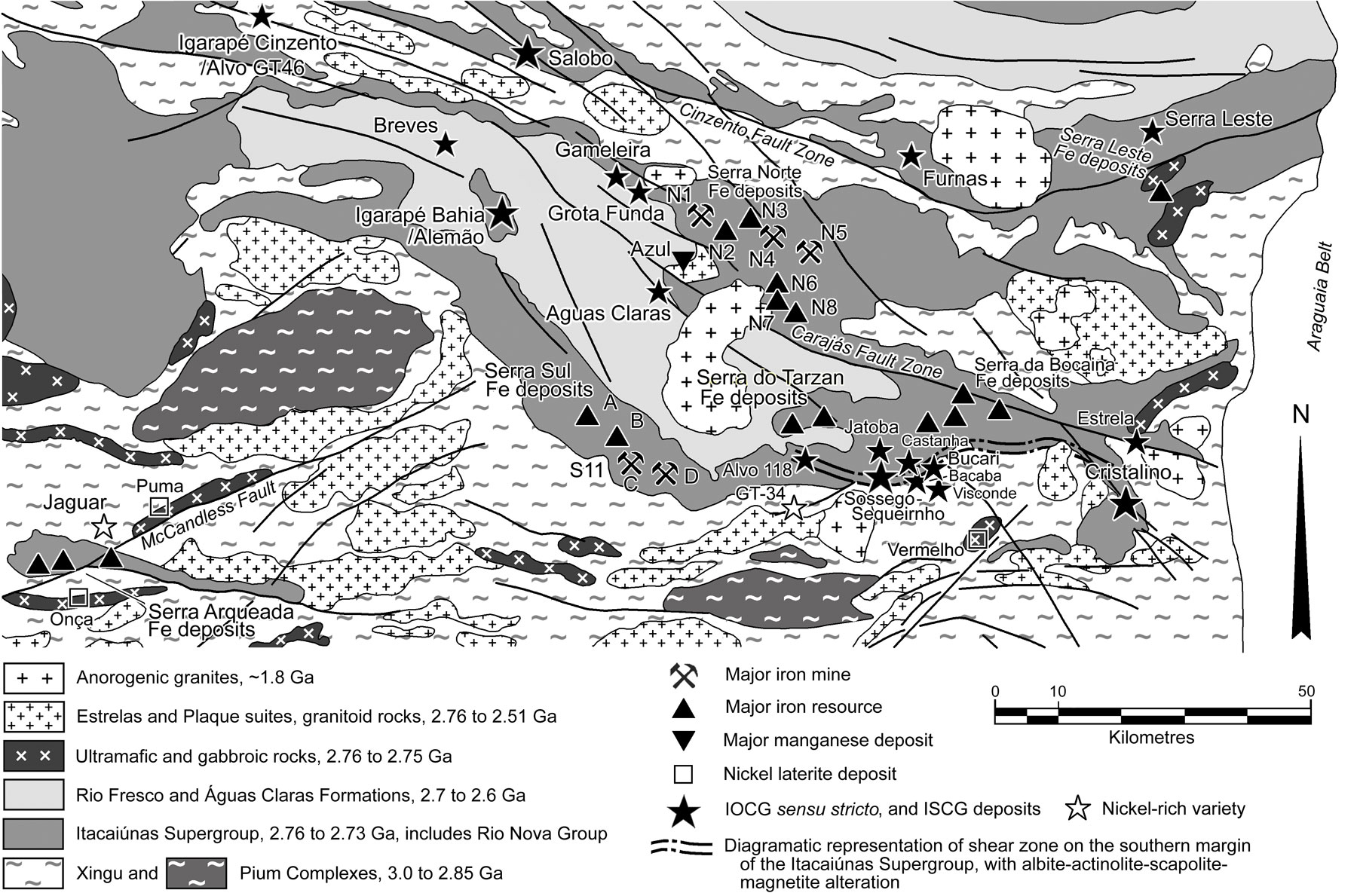 NOTES: This image amalgamates maps covering different parts of the province, and differing interpretations from a range of authors, but gives preference to the most recent. In particular, some authors (e.g., Resende et al., 2021 in the Vale technical reports on the Serra Sul and Serra Norte iron deposits) quote Mesoarchaean ages for the Rio Novo Group of the Adorinhas Supergroup, while others (e.g., Pollard et al., 2018) correlate that unit with the Neoarchaean Grão Pará Supergroup. The former interpretation is used on this map. Similarly, in many interpretations, the corridor between the Cinzento and Carajá fault zones is shown as being occupied by Mesoarchaean Xingu Complex TTGs, intruded by variable, stylised zones of Neoarchaean granitoids. In contrast, others such as Oliveira (2018) of the CPRM and Pollard et al. (2018) map this corridor as Neoarchaean 'felsic magmatism' or 'granites', respectively. It is suspected this zone is occupied by both Meso- and Neo-archaean granitoids to varying degrees, and has been shown above as Neoarchaean granitoids intruding Mesoarchaean TTGs.
NOTES: This image amalgamates maps covering different parts of the province, and differing interpretations from a range of authors, but gives preference to the most recent. In particular, some authors (e.g., Resende et al., 2021 in the Vale technical reports on the Serra Sul and Serra Norte iron deposits) quote Mesoarchaean ages for the Rio Novo Group of the Adorinhas Supergroup, while others (e.g., Pollard et al., 2018) correlate that unit with the Neoarchaean Grão Pará Supergroup. The former interpretation is used on this map. Similarly, in many interpretations, the corridor between the Cinzento and Carajá fault zones is shown as being occupied by Mesoarchaean Xingu Complex TTGs, intruded by variable, stylised zones of Neoarchaean granitoids. In contrast, others such as Oliveira (2018) of the CPRM and Pollard et al. (2018) map this corridor as Neoarchaean 'felsic magmatism' or 'granites', respectively. It is suspected this zone is occupied by both Meso- and Neo-archaean granitoids to varying degrees, and has been shown above as Neoarchaean granitoids intruding Mesoarchaean TTGs.
The protoliths of the high-grade iron ore in the Serra Norte deposits N4E, N4W, N5E, and N5S are the jaspilites, as described above, distributed along, and structurally controlled by, the northern flank of the Carajás fold. High-grade iron mineralisation (>65% Fe) is made up of hard and soft ores. The hard ores can be banded, massive and/or brecciated, and are characterized by hematite-martite and hematite types. The soft ores are very porous, discontinuous and are tabular, friable and banded. The basal contact of high-grade iron ore is defined by a hydrothermally altered basaltic rock mainly composed of chlorite and microplaty hematite (Lobato, et al., 2008).
The jaspilites have been subjected to varying degrees of hydrothermal modification to form iron ores which represent an early hypogene alteration stage. This alteration is zonally distributed around the main ore as follows (after Lobato, et al., 2008):
• The distal expression of this hypogene alteration is mainly characterised by recrystallisation of jasper and the removal of its iron, and the formation of magnetite, which is commonly martitised, overgrowing original microcrystalline hematite and has associated quartz and calcite veins. Two vein breccia types characterise the distal alteration zone: V1a quartz ±sulphide breccias and V1b carbonate ±sulphide breccia veins. The sulphides are pyrite and chalcopyrite.
• The intermediate, peripheral alteration zone was developed synchronously with the main iron ore-forming event, and is characterised by: i). progressive leaching of chert and quartz, producing oxides and vugs; ii). the presence of martite as the dominant oxide following altered jaspilite layers; and iii). partial infill of open spaces by microplaty and/or platy hematite. This intermediate zone is also cut by V2a quartz ±hematite bedding-discordant veins, V2b (discordant, vertical, vug-textured quartz +hematite veins and V3 hematite ±quartz veins that are crosscutting and/or parallel to the jaspilite bedding.
• The proximal alteration zone was also synchronous with the iron ore-forming event, and represents an advanced tage of alteration, and comprises the high-grade iron ore. It is characterised by progressive martitisation, forming anhedral hematite, continued open-space filling by comb-textured euhedral and tabular hematite in veinlets and along banding. This proximal alteration zone contains intense carbonate alteration associated with the high-grade ores, resulting in the production of ore breccias cemented by dolomite. Vein breccias are classified as V4 carbonate (iron cloud)-quartz breccia, and V5 (quartz ±microplaty hematite breccia, both of which occur within in high-grade ore.
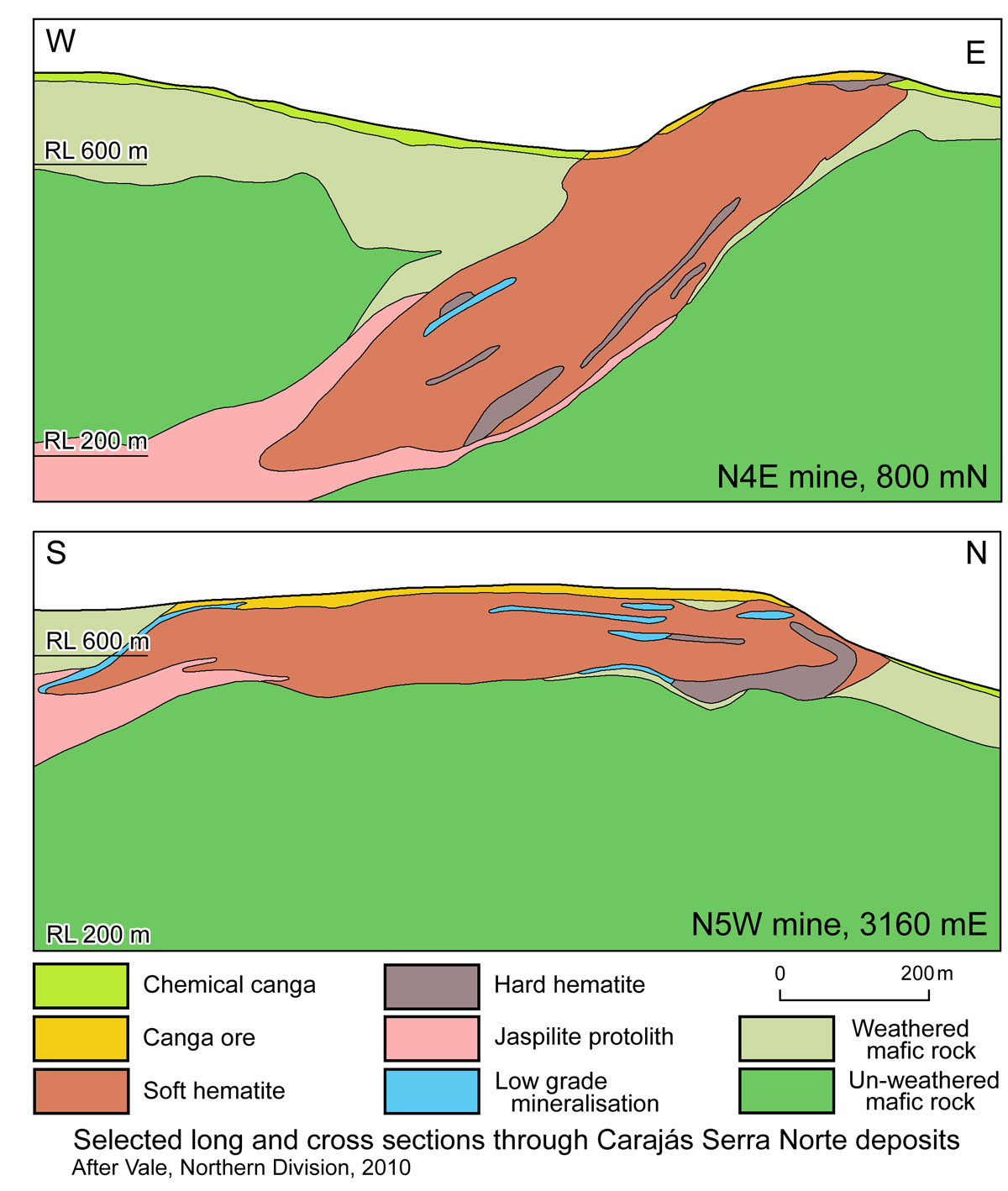
Lobato, et al. (2008) record the following evidence for the influence of hydrothermal fluids. The first evidence for hydrothermal fluids infiltrating the jaspilites is the vein breccia type V1, which contains Ca-Fe rich, high-salinity (up to 29.3 wt.% CaCl2 equiv.) fluid inclusions in quartz and carbonate with Ttrapping of 209 to 285°C. The next stage of hydrothermal fluid infiltration is characterised by vein type V2, containing medium- to high-salinity Na-Fe-Mg–rich (13.6 to 21.2 wt.% CaCl2 equiv.) and Ca rich fluid inclusions (6.8 to 18.4 wt % CaCl2 equiv.) with Ttrapping of 225 to 275°C and 190 to 295°C, respectively. Vein type V3 is characterised by low- and medium-salinity Ca-(Mg)-Fe-Na–rich inclusions (1.2 to 19.2 wt.% CaCl2 equiv.) with Ttrapping of 195 to 255°C and medium-salinity Na-Mg–rich fluid inclusions (8.9 to 14.4 wt % CaCl2 equiv.) with Ttrapping of 240 to 277°C. Brecciated vein types V4 and V5 have Ca-rich, medium- to high-salinity fluid inclusions in quartz and high-salinity inclusions in carbonate (9.7 to 24.5 and 19.2 to 30.1 wt.% CaCl2 equiv., respectively),
both trapped at 237 to 314°C, and low-salinity Na-K-Mg fluid inclusions (0.2 to 7.3 wt.% NaCl equiv.) trapped at 245 to 316°C.
The age of the hypogene alteration and development of high-grade iron ore is considered to be Palaeoproterozoic (Lobato et al., 2005, 2008) and is well correlated with the A-type granites of the Carajás region (e.g., the ~1.8 Ga Serra dos Carajás Granite). Lobato, et al. (2008) also muse that a correlation may exist between the the upgrading of these iron ore deposits and the formation history of hydrothermal magmatic deposits, predominantly rich in Cu and Au (including the extensive IOCG mineralisation), that are distributed throughout the Carajás mineral province, in close proximity to the iron ores, as previously suggested by Lobato et al. (2005).
The ore mined in the Serra Norte comprises three main types:
• Hard hematite which is a compact, blue-grey, massive hematite with a metallic lustre, high density and low porosity. Grades range from 65 to 69% Fe. It is the basis of the mines' export lump ore. This ore generally comprises the high grade mineralisation that has been upgraded from the protore jaspilites by Palaeoproterozoic hypogene alteration, but has not been substantially modified by more recent supergene oxidation.
• Soft hematite, which is composed of massive to banded hematite, that is occasionally pulverised, and is highly porous, very weak and slightly magnetic, and has average grades of ~65% Fe. It is generally sufficiently friable to be mined without blasting and is the main source of sinter and pellet feed products. Supergene enrichment has upgraded hypogene altered jaspilite that ranged from strongly to weakly altered, as well as being responsible for the soft porous nature of the ore.
• Canga, the uppermost unit, that drapes over the deposit and consists of a laterite-saprolite material from weathering of i). the underlying mineralisation (known as 'structural canga', or 'canga ore'), or ii). barren mafic wall rocks (known as Chemical Canga). It is composed of blocks of hematite cemented by hydrated iron oxides (goethite and limonite) and is generally 15 to 20 m thick.
The Carajás BIF/jaspilite unit is evident in the uncleared rain forest as a well demarcated corridor of stunted shrubs and grassland fringed by luxuriant trees over the enclosing mafic wall rocks. The BIFs, canga and their iron ore potential were recognised when a helicopter landed in one of these poorly vegetated clearings at the Serra Arqueada to resupply on July 31 1967. It carried geologist Breno Augusto dos Santos who was working for Cia. Meridional de Mineracao, a subsidiary of United States Steel Corporation, engaged in a regional exploration program looking for manganese. The recognition of the iron formations led to a change in emphasis of the exploration program and the discovery of the major Carajá Serra Norte deposits soon after.
Analyses of the various products in 2010 were, as follows (data provided during mine visit, 2010):
• Sinter Feed - 66% Fe, 0.035% P, 1.40% SiO2, 1.30% Al2O3, 0.65% Mn, with 20% >6.3 mm, 55% >1 mm and 18% <0.15 mm;
• Pellet Feed - 65.3% Fe, 0.040% P, 1.40% SiO2, 1.70% Al2O3, 0.65% Mn, with 5% >0.15 mm, 65% <0.045 mm;
• Lump for domestic market - 63.3% Fe, 0.055% P, 2.30% SiO2, 2.20% Al2O3, 0.95% Mn, with 1% >31.5 mm, 5% >25.0 mm, 12% <6.3 mm.
Reserves/Resources are distributed in a number of deposit groups, the largest of which is the Serra Norte (North Range) with - 6.2 Gt @ 65.8% Fe, 0.038% P, 1.0% SiO2, 1.05% Al2O3, 0.45% Mn, 0.01% S, 0.02% K2O, 0.03% Na2O and 1.88% LOI. The other reserves include: Serra Sul, (South Range) 35 km to the south - 10.4 Gt @ 66.3% Fe; Serra Leste (East Range) - 400 Mt @ 65.9% Fe; and Serra do São Felix - 600 Mt @ 62.8% Fe. The current production contains <1% Al2O3, <1% SiO2, <0.03% P2O5 and <0.3 Mn, with about 10% lump and 90% fines (Mining Technology website viewed December 2021). No resources estimates appear to have been released for the Serra Arqueada, Serra do Tarzan and Serra Bocaina resources. NOTE: Serra de São Felix is ~85 km west to WNW of the Serra Arqueada resource shown in the SW corner of the map above.
Proved + Probable Ore Reserves at the end of 2017 were as follows (Vale Form 20 Report to NYSE, 2017):
Serra Norte - 2.1692 Gt @ 66% Fe; which includes N4W, N4E and N5 mines and N1, N2 and N3 deposits not in operation;
Serra Sul - 4.1953 Gt @ 65.5% Fe; which include the S11C and S11D deposits;
Serra Leste - 258.1 Mt @ 65.4% Fe;
Proved + Probable Ore Reserves at 31 December 2019 totalled 7.3463 Gt @ 65.9% Fe as follows (Vale Form 20 Report to NYSE, 2019):
Serra Norte - 2.8237 Gt @ 65.5% Fe; which includes N3, N4W, N4E and N5 mines and N1, N2 project deposits not in operation;
Serra Sul - 4.1981 Gt @ 66.3% Fe; include the S11C and S11D deposits;
Serra Leste - 324.5 Mt @ 65.1% Fe;
Drill hole spacing used to classify the Reserves were: 150 x 100 m for Proved Reserves and 200 x 200 m for Probable Reserves.
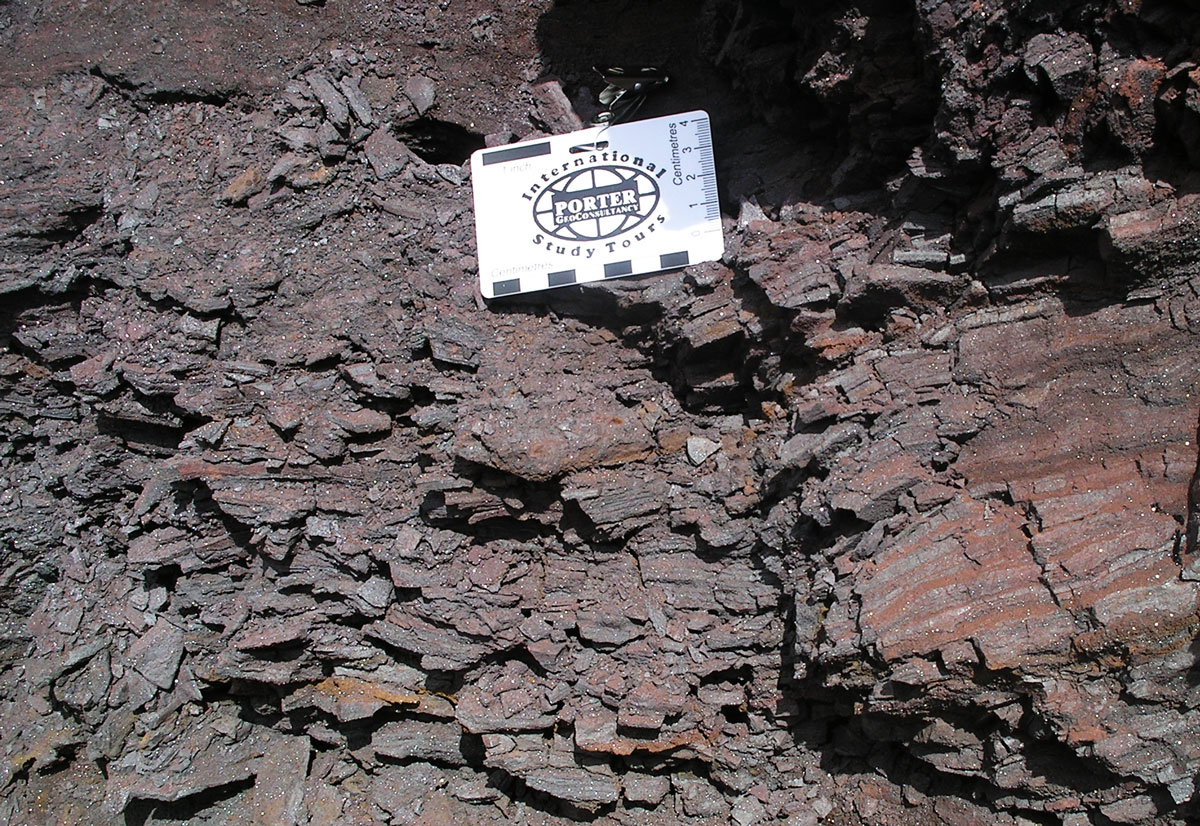
Soft hematite ore - porous, oxidised, physically weak mineralisation in the Carajás N4E mine. Image by Mike Porter, 2010.
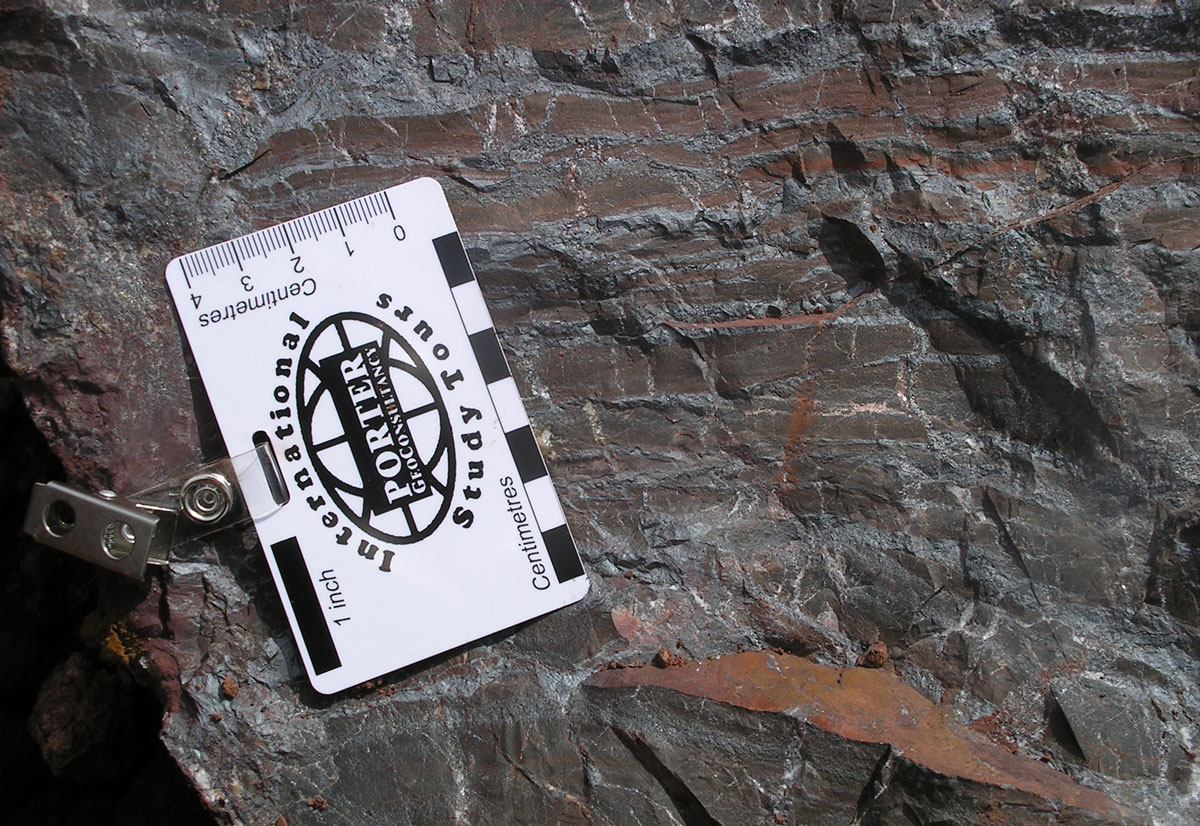
Partially altered jaspilite - intermediate altered, sub-ore grade jaspilite on the margin of the Carajás N4E mine. Image by Mike Porter, 2010.
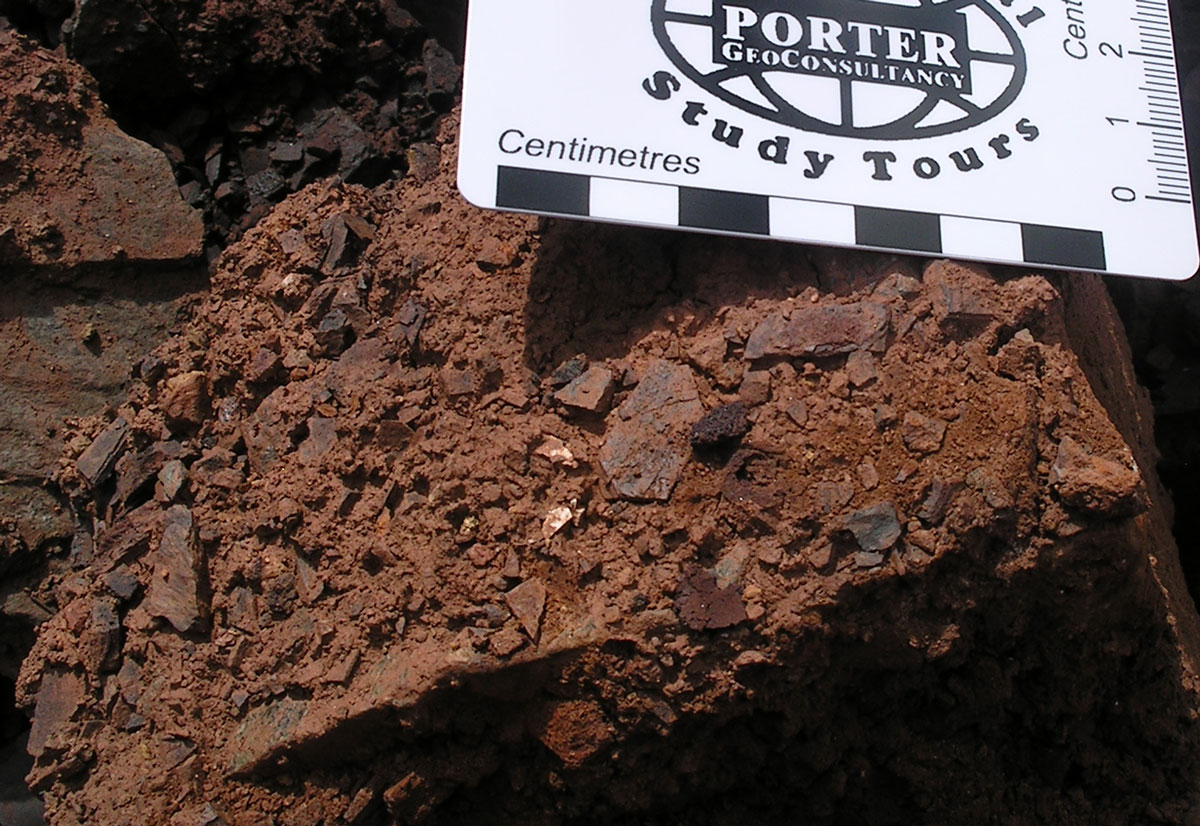
Canga - cemented detrital ore overlying the hematite mineralisation of the Carajás N4E mine. Image by Mike Porter, 2010.
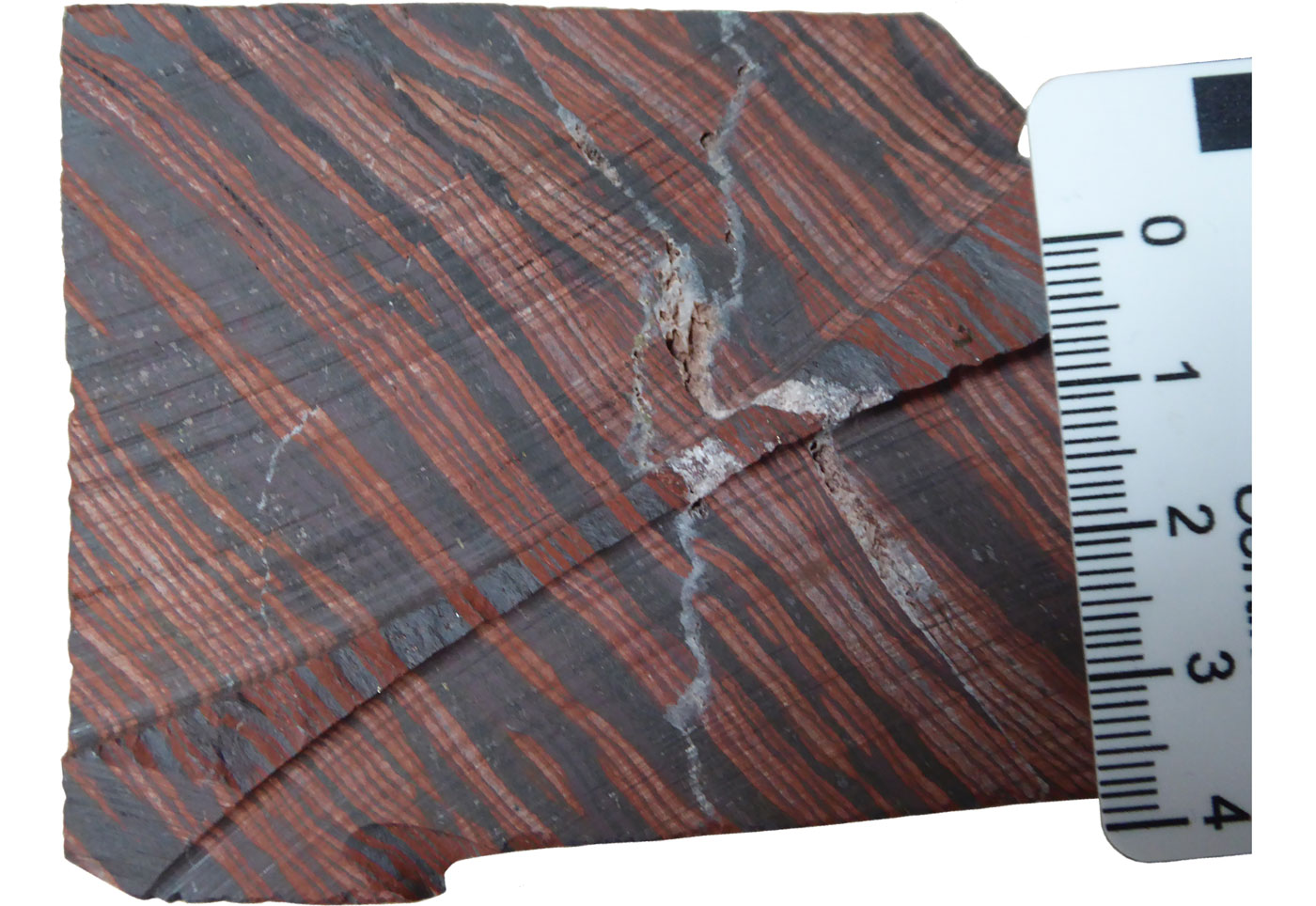
Fresh jaspilite - unaltered primary jaspilite in split drill core from below the base of oxidation from the Carajás Serra Norte. Image by Mike Porter, 2010.
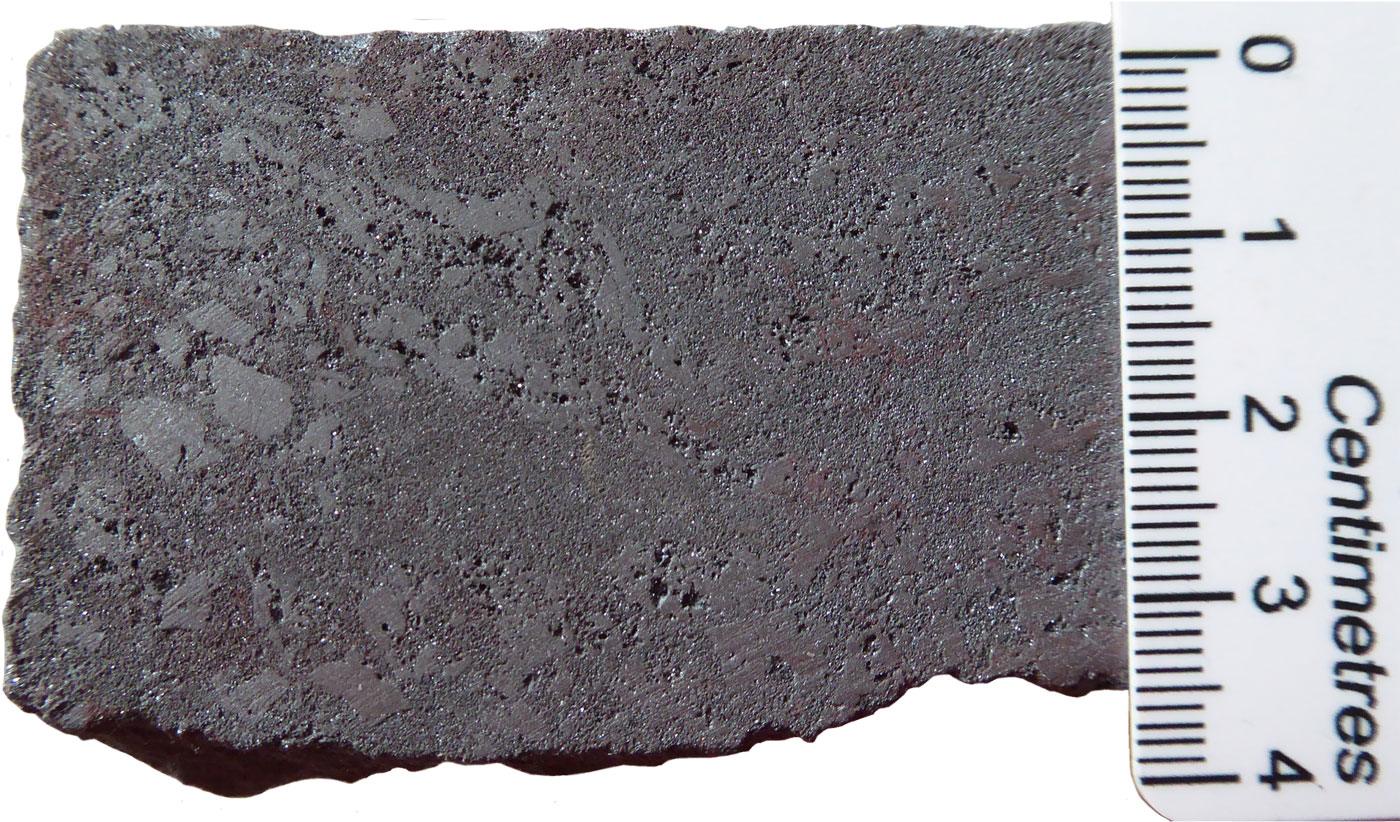
Hard hematite - high grade, hypogene hard hematite in split drill core from below the base of oxidation from the Carajás district. Image by Mike Porter, 2010.
The most recent source geological information used to prepare this decription was dated: 2018.
Record last updated: 8/12/2021
This description is a summary from published sources, the chief of which are listed below.
© Copyright Porter GeoConsultancy Pty Ltd. Unauthorised copying, reproduction, storage or dissemination prohibited.
|
|
|
|
|
Bekker, A., Slack, J.F., Planavsky, N., Krapez, B., Hofmann, A., Konhauser, K.O. and Rouxel, O.J., 2010 - Iron formation: the sedimentary product of a complex interplay among mantle, tectonic, oceanic, and biospheric processes: in Econ. Geol. v.105 pp. 467-508
|
Cabral A R, Costa C H C and Seoane J C S, 2006 - Dreikanter-like pebbles of haematite ore, Carajas, south-eastern Amazonia, Brazil: in Trans. IMM (incorp. AusIMM Proc.), Section B, Appl. Earth Sc. v115 pp 9-12
|
Clout, J.M.F. and Simonson, B.M., 2005 - Precambrian iron formation and iron formation-hosted iron ore deposits: in Hedenquist, J.W., Thompson, J.F.H., Goldfarb, R.J. and Richards, J.P. (eds.), Economic Geology, 100th Anniversary Volume Society of Economic Geologists pp. 643-679
|
Dalstra, H. and Guedes, S., 2004 - Giant Hydrothermal Hematite Deposits with Mg-Fe Metasomatism: A Comparison of the Carajas, Hamersley, and other Iron Ores: in Econ. Geol. v.99, pp. 1793-1800.
|
Dalstra, H. and Rosiere, C.A., 2008 - Structural controls on high-grade iron ores hosted by banded iron formation: A global perspective: in Hagemann S, Rosiere C, Gutzmer J and Beukes N J, (eds.), 2008 Banded Iron Formation-Related High-Grade Iron Ore, Reviews in Economic Geology, v.15 pp. 73-106
|
Figueiredo e Silva R C, Hagemann S, Lobato L M, Rosiere C A, Banks D A, Davidson G J, Vennemann T and Hergt J, 2013 - Hydrothermal Fluid Processes and Evolution of the Giant Serra Norte Jaspilite-Hosted Iron Ore Deposits, Carajas Mineral Province, Brazil: in Econ. Geol. v.108 pp. 739-779
|
Figueiredo e Silva R C, Lobato L M, Rosiere C A, Hagemann S, Zucchetti M, Baars F J, Morais R and Andrade I, 2008 - A Hydrothermal Origin for the Jaspilite-Hosted, Giant Serra Norte Iron Ore Deposits in the Carajas Mineral Province, Para State, Brazil: in Rosiere C A, Spier C A, Rios F J and Suckau V E, 2008 Banded Iron Formation-Related High-Grade Iron Ore Reviews in Economic Geology v15 pp 255-290
|
Guedes SC, Rosiere CA, Barley M, Lobato L 2002 - Carbonate Alteration Associated with the Carajas High-Grade Hematite Deposits, Brazil: in Proceedings, Iron Ore 2002 Conference, 9-11 September 2002, Perth, Western Australia, The AusIMM, Melbourne, pp 63-66
|
Gutzmer, J., Chisonga, B.C., Beukes, N.J. and Mukhopadhyay, J., C.A., 2008 - The geochemistry of banded iron formation-hosted high-grade hematite-martite iron ores: in Hagemann S, Rosiere C, Gutzmer J and Beukes N J, (eds.), 2008 Banded Iron Formation-Related High-Grade Iron Ore, Reviews in Economic Geology v.15 pp. 157-183
|
Hagemann SH, Rosiere CA, Lobato L, Baars F and Zucchetti M, 2005 - Controversy in Genetic Models for Proterozoic High-Grade, Banded Iron Formation (BIF)-Related Iron Deposits - Unifying or Discrete Model(s)?: in Iron Ore 2005 Conference, Perth, WA, September 19-20, 2005 The AusIMM, Melbourne Publication Series 8 pp. 67-71
|
Justoa, A.P., Dantasa, E.L., Bauc, M., Freitas-Silva, F.H., Santosa, R.V., Schorscher, J.H.D., 2020 - Paleobasinal to band scale REE + Y distribution in iron formations from Carajas, Amazon Craton, Brazil: in Ore Geology Reviews v.127, 22p. doi.org/10.1016/j.oregeorev.2020.103750.
|
Klein C, Ladeira E A 2002 - Petrology and geochemistry of the least-altered banded Iron-formation of the Archean Carajas Formation, northern Brazil: in Econ. Geol. v97 pp 643-651
|
Lacasse, C.M., Ganade, C.E., Mathieu, L., Teixeira, N.A., Lopes, L.B.L. and Monteiro, C.F., 2020 - Restoring original composition of hydrothermally altered Archean metavolcanic rocks of the Carajas Mineral Province (Brazil): Geodynamic implications for the transition from lid to mobile tectonics: in Lithos v.372-373, 17p. doi.org/10.1016/j.lithos.2020.105647.
|
Ladeira E A, Cordeiro J R C 1988 - Jazida N4E: Reavaliacao dos Corpos de Hematita Dura e Jaspilitos (English abstract, Portuguese text): in Provincia Mineral de Carajas Litoestratigrafia e Principais Depositos Mainerais; Belem, Companhia Vale do Rio Doce, Sociedade Brasileira de Geologia, XXXV Congresso Brasileiro de Geologia Anexo Aos Anais pp 57-69
|
Lobato L M, Figueiredo e Silva R C, Hagemann S and Thorne W, 2008 - Hypogene Alteration Associated with High-Grade Banded Iron Formation-Related Iron Ore: in Hagemann S, Rosiere C, Gutzmer J and Beukes N J, (eds.), 2008 Banded Iron Formation-Related High-Grade Iron Ore Reviews in Economic Geology v15 pp 107-128
|
Lobato LM, Figueiredo e Silva RC, Rosiere CA, Zucchetti M, Baars FJ, Pimentel M, Rios FJ, Seoane JCS and Monteiro AM, 2005 - Hydrothermal Origin for the Iron Mineralisation, Carajas Province, Para State, Brazil: in Iron Ore 2005 Conference, Perth, WA, September 19-20, 2005 The AusIMM, Melbourne Publication Series 8 pp. 99-110
|
Pinheiro R V L and Holdsworth R E 1997 - The structure of the Carajas N-4 ironstone deposit and associated rocks: relationship to Archaean strike-slip tectonics and basement reactivation in the Amazon region, Brazil: in J. of South American Earth Sciences v10 pp 305-319
|
Rosiere C A, Baars F J, Seoane J C S, Lobato L M, da Silva L L, de Souza S R C and Mendes G E, 2006 - Structure and iron mineralisation of the Carajas Province: in Trans. IMM (incorp. AusIMM Proc.), Section B, Appl. Earth Sc. v115 pp 126-133
|
Teixeira, N.A., Campos, L.D., Paula, R.R.D., Lacasse, C.M., Ganade, C.E., Monteiro, C.F., Lopes, L.B.L., Oliveira, C.G.D., 2021 - Carajas Mineral Province - Example of metallogeny of a rift above a cratonic lithospheric keel: in J. of South American Earth Sciences v.108, doi.org/10.1016/j.jsames.2020.103091
|
|
Porter GeoConsultancy Pty Ltd (PorterGeo) provides access to this database at no charge. It is largely based on scientific papers and reports in the public domain, and was current when the sources consulted were published. While PorterGeo endeavour to ensure the information was accurate at the time of compilation and subsequent updating, PorterGeo, its employees and servants: i). do not warrant, or make any representation regarding the use, or results of the use of the information contained herein as to its correctness, accuracy, currency, or otherwise; and ii). expressly disclaim all liability or responsibility to any person using the information or conclusions contained herein.
|
Top | Search Again | PGC Home | Terms & Conditions
|
|